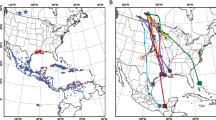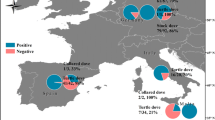Abstract
Finch trichomonosis emerged in Great Britain in 2005 and led to epidemic mortality and a significant population decline of greenfinches, Carduelis chloris and chaffinches, Fringilla coelebs, in the central and western counties of England and Wales in the autumn of 2006. In this article, we show continued epidemic spread of the disease with a pronounced shift in geographical distribution towards eastern England in 2007. This was followed by international spread to southern Fennoscandia where cases were confirmed at multiple sites in the summer of 2008. Sequence data of the ITS1/5.8S/ITS2 ribosomal region and part of the small subunit (SSU) rRNA gene showed no variation between the British and Fennoscandian parasite strains of Trichomonas gallinae. Epidemiological and historical ring return data support bird migration as a plausible mechanism for the observed pattern of disease spread, and suggest the chaffinch as the most likely primary vector. This finding is novel since, although intuitive, confirmed disease spread by migratory birds is very rare and, when it has been recognised, this has generally been for diseases caused by viral pathogens. We believe this to be the first documented case of the spread of a protozoal emerging infectious disease by migrating birds.





Similar content being viewed by others
References
Anderson NL, Grahn RA, Van Hoosear K, Bondurant RH (2009) Studies of trichomonad protozoa in free ranging songbirds: Prevalence of Trichomonas gallinae in house finches (Carpodacus mexicanus) and corvids and a novel trichomonad in mockingbirds (Mimus polyglottos). Veterinary Parasitology 161:178-186.
Bakken V, Runde O, Tjørve E (2006) Norsk Ringmerkingsatlas Vol 2., p. 446. Stavanger, Norway: Stavanger Museum.
Bondurant RH, Honigberg BM (1994) Trichomonads of veterinary importance. In: Parasitic Protozoa Kreier JP (editor), pp. 111-206. New York, USA: Academic Press.
Bradley CA, Altizer S (2007) Urbanization and the ecology of wildlife diseases. Trends in Ecology and Evolution 22:95-102.
Cannon AR, Chamberlain DE, Toms MP, Hatchwell BJ, Gaston KJ (2005) Trends in the use of private gardens by wild birds in Great Britain, 1995-2002. Journal of Applied Ecology 42:659-671.
Chalmers GA (1992) Trichomoniasis in finches. Canadian Veterinary Journal. 33:616-617.
Coiffait L, Clark JA, Robinson RA, Blackburn JR, Granthan MJ, Leech DI, et al.(2009) Bird ringing in Britain and Ireland in 2008. Bird Study 24:281-320.
Cramp S, Perrins CM (1994) Birds of the western Palaearctic, Vol VIII, pp. 548-568. Oxford, UK: Oxford University Press.
Daszak P, Cunningham AA, Hyatt AD (2001) Anthropogenic environmental change and the emergence of infectious diseases in wildlife. Acta Tropica 78:103-116.
Dhondt AA, Tessaglia DL, Slothower RL (1998) Epidemic mycoplasmal conjunctivitis in house finches from Eastern North America. Journal of Wildlife Diseases 34: 265-280.
Erwin KG, Kloss C, Lyles J, Felderhoff J, Fedynich AM, Henke SE, et al.(2000) Survival of Trichomonas gallinae in white-winged dove carcasses. Journal of Wildlife Diseases 36:551-554.
Felleisen RSJ (1997) Comparative sequence analysis of 5.8S rRNA genes and internal transcribed spacer (ITS) regions of trichomonadid protozoa. Parasitology 115:111-119.
Forrester DJ, Foster GW (2008) Trichomonosis. In Parasitic diseases of wild birds Atkinson CT, Thomas NJ, Hunter DB (editors), pp. 120-153. Iowa: Wiley-Blackwell.
Gaspar da Silva D, Barton E, Bunbury N, Lunness P, Bell DJ, Tyler KM (2007) Molecular identity and heterogeneity of Trichomonad parasites in a closed avian population. Infection, Genetics and Evolution 7:433-440.
Gauthier-Clerc M, Lebarbenchon C, Thomas F (2007) Recent expansion of highly pathogenic avian influenza H5N1: a critical review. Ibis 149:202-214.
Gerhold RW, Yabsley MJ, Smith AJ, Ostergaard E, Mannan W, Cann JD, et al.(2008) Molecular characterization of the Trichomonas gallinae morphologic complex in the United States. Journal of Parasitology 94:1335-1341.
Gilbert M, Xiao X, Domenech J, Lubroth J, Martin V, Slingenbergh J (2006) Anatidae migration in the western Palearctic and spread of highly pathogenic avian influenza H5NI virus. Emerging Infectious Diseases 12:1650-1656.
Grabensteiner E, Bilick I., Kolbek T, Hess M (2010) Molecular analysis of clonal trichomonad isolates indicate the existence of heterogenic species present in different birds and within the same host. Veterinary Parasitology 172:53-64.
Hosseini PR, Dhondt AA, Dobson AP (2006) Spatial spread of an emerging infectious disease: conjunctivitis in house finches. Ecology 87:3037-3046.
Keawcharoen J, van Riel D, van Amerongen G, Bestebroer T, Beyer WE, van Lavieren R, et al. (2008) Wild ducks as long-distance vectors of highly pathogenic avian influenza virus (H5N1). Emerging Infectious Diseases 14:600-607.
Kilpatrick AM, Chmura AA, Gibbons DW, Fleischer RC, Marra PP, Daszak P (2006) Predicting the global spread of H5N1 avian influenza. Proceedings of the National Academy of Sciences. 103:19368-19373.
Kocan RM, Herman CM (1971) Trichomoniasis In: Infectious and parasitic diseases of wild birds. Davis JW, Anderson RC, Karstad L, Trainer DO, pp 282-290. Ames IA, Iowa State University Press.
Lack PC (1986) The Atlas of Wintering Birds in Britain and Ireland, pp. 1-448. London, UK: T. & T. A. Poyser.
Lawson B, Cunningham A, Chantrey J, Hughes L, Kirkwood J, Pennycott T, et al.(2006) Epidemic finch mortality. Veterinary Record 159:367.
Lawson B, Howard T, Macgregor SK, Perkins M, Robinson R, Kirkwood JK, et al. (2010) The epidemiology of salmonellosis in garden birds in England and Wales, 1993 to 2003. Ecohealth. doi:10.1007/s10393-010-0349-3 [Online 14 October, 2010].
Main IG (1996) Seasonal movements of British Greenfinches Carduelis chloris. Bird Study 43:240-252.
Main IG (1999) Overseas movements to and from Britain by Greenfinches Carduelis chloris. Ringing and Migration 20:167-180.
Neimanis AS, Handeland K, Isomursu M, Ågren E, Mattsson R, Hamnes IS, et al. (2010) First report of epizootic trichomoniasis in wild finches (Family Fringillidae) in southern Fennoscandia. Avian Diseases 54:136-141.
Nemeth NM., Young GR, Burkhalter KL, Brault AC, Reisen WK, Komar N (2009) West Nile virus detection in nonvascular feathers from avian carcasses. Journal of Veterinary Medical Science 21:616-622.
Newton I (1972) Finches, pp.1-288. The New Naturalist, Collins.
Norman D (2002) Chaffinch Fringilla coelebs. In The Migration Atlas: Movements of the Birds of Britain and Ireland Wernham CV, Toms MP, Marchant JH, Clark JA, Siriwardena GM, Baille SR), pp. 637-640. London, UK: T. & A.D. Poyser.
Olsen B, Munster VJ, Wallensten A, Waldenstrom J, Osterhaus A, Fouchier RAM (2006) Global patterns of influenza A virus in wild birds. Science 312: 384-388.
Pennycott TW, Cinderey RN, Park A, Mather HA, Foster G (2002) Salmonella enterica subspecies enterica serotype Typhimurium and Escherichia coli 086 in wild birds at two garden sites in south-west Scotland. Veterinary Record 151:563-567.
Pennycott TW, Lawson B, Cunningham AA, Simpson V, Chantrey J (2005) Necrotic ingluvitis in wild finches. Veterinary Record 157:360.
Peters M, Kilwinski J, Reckling D, Henning K (2009) Gehäufte Todesfälle von wild lebenden Grünfinken an Futterstellen infolge Trichomonas-gallinae-Infektionen – ein aktuelles Problem in Norddeutschland. Kleintierpraxis 54:433–438.
Robinson RA, Grantham MJ, Clark JA (2009) Declining rates of recovery in British birds. Ringing and Migration. 24:266-272.
Robinson RA, Lawson B, Toms MP, Peck KM, Kirkwood JK, Chantrey J, et al. (2010) Emerging infectious disease leads to rapid population declines of common British birds. PLoS ONE 55:e12215. doi:10.1371/journal.pone.0012215 [Online, August 18, 2010].
Speek G, Clark J, Rhode Z, Wassenaar RD, Van Noordwijk AJ (2001) The Euring Exchange code 2000, pp. 1-143. Heteren, Netherlands: Euring.
Tasca T, De Carli GT (2003) Scanning electron microscopy study of Trichomonas gallinae. Veterinary Parasitology 118: 37-42.
USGS National Wildlife Health Centre Quarterly Wildlife Mortality Report October 2002 to December 2002 [accessed Dec 7 2010] http://www.nwhc.usgs.gov/publications/quarterly_reports/2002_qtr_4.jsp.
Väisänen RA, Koskimies P (1991) Monitoring Bird Populations. A Manual of Methods Applied in Finland, University of Helsinki, pp 1–144.
Weber TP, Stilianakis NI (2007) Ecologic immunology of avian influenza. Emerging Infectious Diseases 13:1139-1143.
Wernham CV, Toms MP, Marchant JH, Clark JA, Siriwardena GM, Baillie SR (2002) The Migration Atlas: movements of the birds of Britain and Ireland, pp. 1-884. London, UK: T. & A.D. Poyser.
Yamamato Y, Nakamura K, Yamada M, Ito T (2009) Zoonotic risk for influenza A (H5N1) infection in wild swan feathers. Journal of Veterinary Medical Science 71:1549-1551.
Acknowledgements
Tha authors thank the BTO Garden BirdWatch participants, Varpu Hirvelä-Koski, Perttu Koski, Petra Heikkinen and Roland Mattson. The British and Irish Ringing Scheme is funded through a partnership between the BTO, the Joint Nature Conservation Committee (on behalf of Natural England, Scottish Natural Heritage, the Countryside Council for Wales and the Council for Nature Conservation and the Countryside in Northern Ireland), BirdWatch Ireland and the ringers themselves. We thank all those who have marked or reported birds over the years. This is a publication of the Garden Bird Health initiative, which received financial support from the following organisations; Birdcare Standards Association, British Trust for Ornithology, British Veterinary Association Animal Welfare Foundation, CJ Wildbird Foods, Cranswick Pet Products, Defra, Gardman Ltd, RCVS Trust Small Grants Programme Reference 000443, RSPB, John and Pamela Salter Trust (R16982), Tom Chambers Ltd., and the Universities Federation for Animal Welfare.
Author information
Authors and Affiliations
Corresponding author
Rights and permissions
About this article
Cite this article
Lawson, B., Robinson, R.A., Neimanis, A. et al. Evidence of Spread of the Emerging Infectious Disease, Finch Trichomonosis, by Migrating birds. EcoHealth 8, 143–153 (2011). https://doi.org/10.1007/s10393-011-0696-8
Received:
Revised:
Accepted:
Published:
Issue Date:
DOI: https://doi.org/10.1007/s10393-011-0696-8




